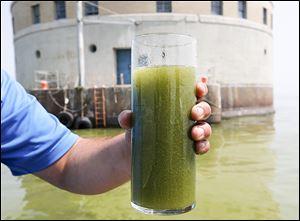
FEATURED EDITORIAL
Feds tell Lake Erie to drop dead
5/26/2017It is outrageous and disheartening that the federal government has turned its back on Lake Erie.
But it has.
Click here to read more Blade editorials

A glass of algae-filled Lake Erie water near the Toledo water intake crib in 2014. Some elements are in place for a similar water crisis in 2017, early reports show.
There will be no impaired water designation for the lake, and the Trump Administration hopes to eliminate a program that has funded many water quality improvements.
The threat of a repeat of the water crisis that crippled the Toledo region in 2014 is very real, and it is now up to local and state officials to do what they have been elected to do — lead. The lake is the state’s, and the region’s, most precious resource, and millions of Ohioans rely on it for their drinking water. Thousands more rely on it for a living — tourism driven by boating, birding, and fishing.
A large coalition of environmentalists attempted to get the U.S. EPA to step in and declare western Lake Erie “impaired,” which would result in an evaluation and assessment of all the causes of pollution of the lake, a mandatory action plan and timetable for cleaning it up, and federal money to accomplish all of the above.
The government rejected the overtures, however, saying that it will defer to the state government’s decision to keep the lake off its impaired waterways list.
Toledo Mayor Paula Hicks-Hudson and Gov. John Kasich have resisted calls to seek impaired status for Lake Erie, fearing the label will give the region an economic black eye. It is a shallow argument.
Clearly, the region endured a public relations nightmare in August, 2014, when 500,000 people had to figure out where to find safe drinking water after toxic algae polluted the Toledo supply. The black eye will be even uglier if this happens again.
What is a greater concern to those who might want to invest in Toledo: uncertainty over when the next water crisis may hit because state and local officials don’t have the resources to stop it from happening, or learning that the federal government is involved to ensure that a water outage never happens again?
But, for now, Washington has made that question moot. The feds have abandoned Lake Erie, and the state of Ohio. The future and health of Lake Erie falls fully on local and state officials. And that is a chilling thought. For local and state officials have done little up to now. Their formula is lethargy, denial, and empty blatherings of concern. That formula will never clean up Lake Erie.
Toledoans went three days without clean water in 2014, and a May 9 report by the NOAA and Heidelberg University indicates that the same amount of phosphorous is in the lake this year as was last year. The totals are ahead of pace in the Maumee River. All the elements are in place for a repeat of 2014.
As an added insult, the Trump Administration again is foolishly attempting to eliminate the Great Lakes Restoration Initiative, which has pumped roughly $300 million a year into water quality efforts for the lakes.
Once again, Sens. Rob Portman (R., Ohio) and Sherrod Brown (D., Ohio), along with Rep. Marcy Kaptur (D., Toledo), will need to dig into their bag of political tricks to save funding for the GLRI.
Those three individuals, and the courts, are the hope for Lake Erie now.